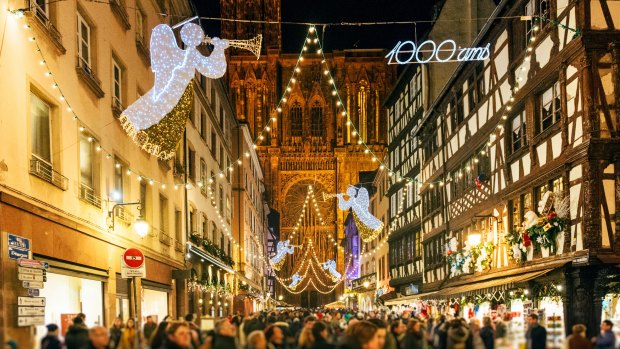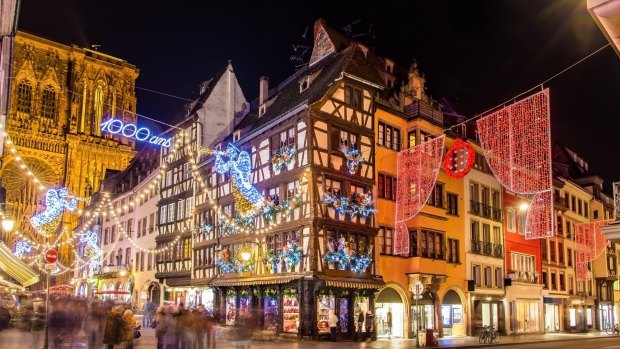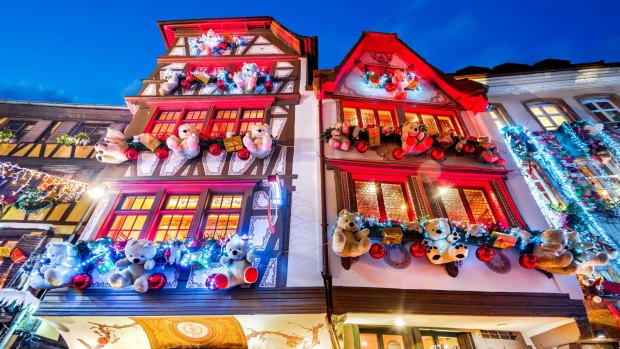This was published 2 years ago
Strasbourg, France: The European 'Christmas capital' you need to visit at least once

Tourists admire Christmas decorations on the iconic Rue Merciere.Credit: Getty
We left Paris in darkness. As our high-speed train raced toward the German border at nearly 200 mph, the rain furiously lashed the windows. Instead of a blanket of snow, the fields of Alsace reflected a soggy sheen as the winter day broke cold and late.
There are Christmas markets, and then there's Strasbourg. I had booked a last-minute trip to this city in eastern France for my Christmas-obsessed 11-year-old daughter, Jane. Dating to 1570, Strasbourg's is one of Europe's oldest Christmas markets, and it's in a class of its own. The entire city is transformed with multiple themed markets, concerts, exhibitions and a festive vibe that attracts about 2 million visitors per year. Because of the pandemic closure in 2020, there was enormous pent-up demand for this year's event. Needless to say, when I searched online for hotels, there was no room at the inn, so we opted to do a day trip, which the TGV makes possible in 2 hours, 20 minutes.
Our yuletide enthusiasm is not universally shared. For my husband, a Christmas market is a commercial fair with faux Alpine chalets hawking mass-produced trinkets. True, the proliferation of such markets has sometimes resulted in cliche-ridden affairs with bad music and cheap imports. But he hasn't seen Strasbourg. Steeped in tradition, the city strives to nurture authenticity and showcase artisans. Its dedicated website offers an illustrated map with descriptions of the merchants (noel.strasbourg.eu/en/chalets). To make the most of our time, I mapped out our route in advance. I hadn't anticipated popping open umbrellas when we alighted from the train, but our excitement couldn't be dampened.

Strasbourg has one of Europe's oldest Christmas markets.Credit: Alamy
It actually began in the Middle Ages as a market dedicated to Saint Nicholas, whose feast day is celebrated on December 6. An independent republic within the Holy Roman Empire, Strasbourg converted to Protestantism during the Reformation, so the market was rebranded to the Christkindelsmärik ("baby Jesus market" in Alsatian) to dissociate from Catholic customs and the cult of the saints. Louis XIV annexed Strasbourg to France in the 17th century, and the Alsace region became the object of a tug of war between France and Germany until the end of the Second World War. Today home to the European Parliament, the city is a symbol of continental unity.
In 1992, the mayor's office launched "Strasbourg, Capital of Christmas," and the market morphed into its current incarnation: a citywide extravaganza with about 300 chalets spilling across squares and streets in the UNESCO-listed city centre. A major boost for tourism, the event's runaway success has led to concerted efforts to champion authenticity, with vendors carefully vetted and some products banned. In 2010, the city said au revoir to the churro, the sugar-dusted fried dough with Spanish origins, alongside the panini, the hot sandwich that's most often equated with Italy, in favour of local culinary delicacies such as kouglof (a raisin-studded sweet brioche), bretzels (pretzels) and choucroute (sauerkraut).
Customs and rituals are abundant. During Advent, families decorate trees and set up elaborate Nativity scenes populated with an entire village of tiny figurines. And then there's the bredle. In Alsace, there's not just one Christmas cookie, but dozens of varieties, each with its own name, the recipes passed down for generations. Just a sampling: the étoile cannelle is a star-shaped treat fragrant with cinnamon; spritzbredle is made from ground almonds; and anisbredle is flavored with aniseed. You can pick and choose from the cornucopia on display at the Bas-Rhin bakers federation; these industrious boulangers set up a tent on the Place du Marché-aux-Poissons and offer workshops and recipe booklets.

Street winter decorations in central Strasbourg.Credit: Alamy
Beyond baking, the city's decor also requires months of work. The Place Kléber shows off Europe's tallest decorated Christmas tree, at more than 100 feet. The national forestry office scouts the neighbouring forests of Alsace, Moselle and the Vosges to find the perfect tree, which is then hoisted on a truck, erected in the square, filled out with additional greenery, and decorated with more than four miles of string lights and hundreds of ornaments over a three-week period.
The city where Johannes Gutenberg invented the moveable-type printing press also promotes humanist values and a sense of community at the Christmas market. In the Village du Partage ("Sharing Village") adjacent to the giant tree, some 90 nonprofits and organizations explain their missions and accept donations. Here you can warm up with the soupe étoilée ("starred soup"), concocted from the recipes of four Michelin-starred chefs, which raises money for Humanis, a nonprofit collective behind solidarity projects.
There's a joy in the anticipation of Christmas. For Jane, it started in September when she began a stealthy project with her sister. I assumed it had to do with the imagined toy extravaganza on December 25. When I was finally let in on the secret, I was taken by surprise. Jane had been plotting a list of the perfect gifts for each member of her extended family, using her allowance and keeping elaborate charts. Noël means giving, I was reminded by an 11-year-old.
In Strasbourg, the gifts have more cachet because of the artisans who make them. Among the treasures were natural soaps created in Alsace by Argasol, handmade wooden toys by Brin d'Ours and pain d'épices (gingerbread) by Mireille Oster. The self-proclaimed "ambassadrice" of this honey-rich cake has two gourmet boutiques in Strasbourg and two stands on the Christmas market. (She follows in the footsteps of her grandparents, who sold pain d'épices at the market starting in 1933.) Reinventing classic recipes, Oster incorporates unusual ingredients from her travels, such as goji berries, ginger, dates and orange blossom.
"It just keeps going," Jane said incredulously as we roamed Strasbourg. At this point, we had scoped several stands on the hunt for Poterie Fortuné Schmitter, and it was Jane who finally spied the distinctive blue colours across the Place de la Cathédrale. This seventh-generation business is one of the last remaining potters to craft the renowned salt-glazed stoneware from Betschdorf, a village at the edge of the Forest of Haguenau. What's unique is the ancestral technique: When cooking the clay at temperatures of 1,250 degrees Celsius, salt is thrown into the kiln, forming a fine natural glaze. Their products run the gamut from pitchers and conserve pots to beer mugs and Christmas ornaments.
"The Strasbourg Christmas market is a real showcase for us," Luce Schmitter said of the event where they've had a stand for 23 years. "We can speak of our savoir-faire to people from all over the world."
There's always a line at the chalet for the Centre international d'art verrier (CIAV) glass centre. Famed around the world, these in-demand Christmas balls have even been incorporated into the 2021 Advent calendar created by Paris pastry chef Pierre Hermé. After all, the very Christmas ball itself - that ubiquitous ornament found on trees all over the planet - traces its origins to a glassworks in the Vosges. "The story goes that there was a drought in 1858, so there was a lack of apples and pine cones and other things used for decorating Christmas trees," explained Esther Abel, archives and heritage manager at CIAV. "A glassmaker in Goetzenbruck made small balls and gave them to the village, and the idea caught on."
Today, the tradition is kept alive at CIAV, where the last remaining Goetzenbruck glassmakers were asked to share their expertise in 1998. (The vast Meisenthal glassworks was first established in 1704 and produced millions of cheap glassware before closing in 1969, leaving behind an industrial wasteland. The place was revived in 1992 as CIAV, its mission to preserve traditional glass-blowing techniques.) For the past two decades, CIAV has offered a limited-edition contemporary Christmas ball created by an artist, alongside its classic collections. "It's a secret process, and the unveiling announcement is a real event," Abel said. Only 25,000 are produced a year - "the human artistry is respected; this isn't a Christmas ball factory"- so Jane and I were happy to get our hands on two (the permitted limit) of the Piaf ("sparrow"), designed by artist Harmonie Begon in a range of colours.
We took refuge from the rain at the newly opened Hôtel Léonor. Jane loves hotels as much as I do (for her, it's all about breakfast; for me, it's the stories), and this one was particularly alluring, the result of a four-year restoration of a historical landmark that was once the home of an Alsace governor and marshal of France. Behind the neoclassical facade, the ambiance is trendy and chic, particularly in the restaurant. It's overseen by Nicolas Stamm and Serge Schaal, who hold two Michelin stars at La Fourchette des Ducs in Obernai. Watching the rain out the window, we took our time over lunch: crispy chicken with sweet potato puree and a trout tartare in an emulsion of Bibeleskaes, the Alsatian fromage blanc.
Another rain shower saw us sheltering inside the Strasbourg Cathedral, a soaring red-hued masterpiece in Gothic and Romanesque styles. When the steeple was completed in 1439, the cathedral reigned as the world's tallest building until 1874. Inside, the astronomical clock gets all the visitor love, but what stole my attention was the tapestry exhibition. Suspended on each side of the nave during Advent, a collection of 14 tapestries from the 17th century depict the life of the Virgin Mary. And the Nativity scene, running 55 feet, even includes an enormous elephant and camels accompanying the three Magi.
Night fell early, as if on cue, at 4:30pm. Suddenly the lights blazed and Strasbourg was illuminated so brightly it seemed like daytime. The cathedral bells began to toll simultaneously, resounding across the ville, and we had to stop in our tracks. In the Carré d'Or, a district in the historic city centre, we spied dozens of iPhones poised in the air to capture the scene. The shopkeepers famously go all out with their decor, the half-timbered houses festooned with stuffed animals, evergreens and frosted branches beneath strands of lights that run the length of the street. Strasbourg is said to be the most illuminated city in Europe during the period of Advent, and it was by the river that we were bowled over: luminous stars strung in the trees as far as we could see.
The rain resumed, and we ducked under a cheery tent on the Rohan Palace terrace, where culinary vendors congregate. This particular spot, the Tribu des Gourmets, advocates for the sometimes misunderstood wines of Alsace, promoting the city's important historical links with the vineyards. Hot mulled wine is prolific at the Christmas market; to curb trash, you pay a deposit on a goblet that is returned when you hand over your empty cup to any merchant. But here, there's pride in the ancestral recipe, made with dry white wine instead of red.
Backs aching from hauling our purchases, we removed our packs and wrapped our numb fingers around steaming cups (Jane's hot apple juice as fragrant as the orange- and cinnamon-scented wine). Star lanterns glowed overhead, spice smells wafted from the cauldrons and laughter trickled over the crowd. Side by side, we watched the canal boats ply the waters in the pouring rain. "Let's stay the night next year," Jane said.
MORE
noel.strasbourg.eu/en; visitstrasbourg.fr/en/welcome-in-strasbourg
A free citywide event features multiple markets in streets and squares in the UNESCO-listed city centre. Each location has something to offer: The market on Place Broglie is dedicated to ornaments and decorations, while the market on Place Kléber has the tallest decorated Christmas tree in Europe. Find gourmet food on the terrace of the Rohan Palace, while the Place de la Cathédrale is particularly scenic, with the centuries-old cathedral soaring over the chalets and half-timbered houses. Masks required; some individual markets require French health pass. Open daily 11am to 8pm and until 6pm December 24; 2 to 6 pm December 25 and noon to 6pm December 26. Free entry.
The Washington Post
Sign up for the Traveller Deals newsletter
Get exclusive travel deals delivered straight to your inbox. Sign up now.